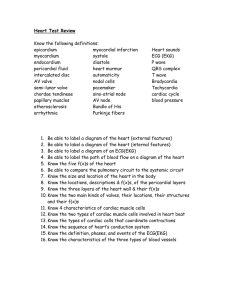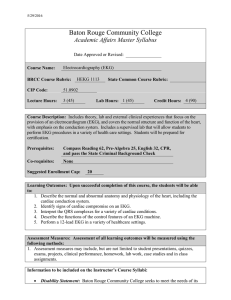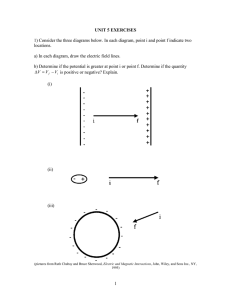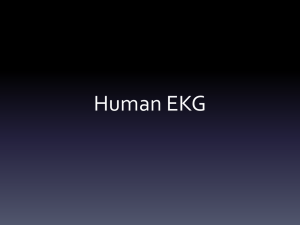Modalities of Cardiac Stress Test Tiffany T. Nguyen MD April 2014
advertisement
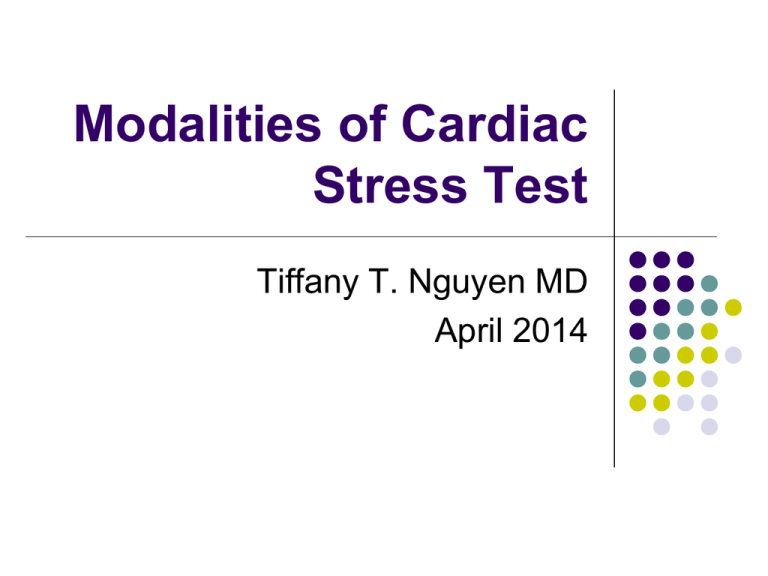
Modalities of Cardiac Stress Test Tiffany T. Nguyen MD April 2014 Objectives To understand the indications and contraindications for stress testing. To learn the different modalities of cardiac stress test. To effectively select the optimal cardiac stress test for each patient. Indications Who to stress? Symptoms suggesting angina. Acute chest pain Recent ACS after 3 months of conservative therapy Known CHD and change in clinical status. Prior coronary revascularization. Valvular heart disease. New heart failure or cardiomyopathy. Chronic left ventricular dysfunction and CHD who are candidates for revascularization. Selected arrhythmias Undergoing non-urgent non-cardiac surgery. Contraindications Who NOT to stress? Unstable angina Acute myocardial infarction Arrhythmia with hemodynamic instability Aortic dissection Symptomatic aortic stenosis Symptomatic severe heart failure Pulmonary embolism Myocarditis, Pericarditis Pre-Test Probability ACC/AHA 2012 Guidelines Low probability - <10% - no further testing, except for prognostic information. Intermediate probability - 10-90% - non-invasive testing for diagnosis (exercise ECG as first modality). High probability - >90% - non invasive testing for prognosis/management prior to cardiac cath. Age Nonanginal pain Atypical angina Typical angina Men Women Men Women Men Women 30-39 4% 2% 34% 12% 76% 26% 40-49 13% 3% 51% 22% 87% 55% 50-59 20% 7% 65% 31% 93% 73% 60-69 27% 14% 72% 51% 94% 86% Two Components Each cardiac imaging modality has two components: Stressing agent: treadmill, dobutamine, or adenosine Imaging agent: EKG, echo, or radionuclide tracer (thallium or technetium) Stressing Agents Stressor Pro Con Treadmill Physiologic, simple, less expensive, good for patient who can walk Dobutamine No exercise needed Caution in patients with arrhythmias Adenosine or dipyridamole (used with nuclear) No exercise needed; uncomfortable sensation of “heart stoppage” Adenosine may induce bronchospasm – caution in COPD and asthma! Imaging Agents Stressor Pro Con EKG Simple, less expensive Less information. May not be able to localize the lesion. Can not use if there are baseline EKG abnormalities i.e. LBBB with ST changes Echocardiogram Good if patient has pre-existing EKG abnormalities. More info than EKG. Less expensive than nuclear. Operator dependent to some extent. May have poor windows due to body habitus. Preexisting wall motion abnormalities may make interpretation more challenging. Thallium or technetium Localizes ischemia and infarcted tissue. Expensive Finally … What is a “MIBI?” What is a “Lexiscan?” Both are adenosine nuclear stress tests MIBI: the technetium molecule is attached to sestamibi molecule. The combined sestamibiTechnitium-99 molecule is aka “cardiolite” Lexiscan: uses a derivative of adenosine called regadenosine, which has 2-3 minute half-life instead of 30sec, so is easier to work with. Sensitivity and Specificity Exercise EKG Sensitivity 68% Specificity 77% Stress Echo 76% 88% Nuclear Imaging 79-92% 73-88% Selecting Modalities Indication Diagnosis or Prognosis Localize Ischemia Exercise? Exercise? no no yes Pharmacologic test with Imaging Normal EKG Not on Digoxin No prior revascularization yes Exercise EKG no Exercise Imaging yes Case Question A 60yo man is evaluated for chest pain of 4 months’ duration. He describes the pain as sharp, located in the left chest, with no radiation or associated symptoms, that occurred with walking one to two blocks and resolves with rest. Occasionally, the pain improves with continued walking or occurs during the evening hours. He has hypertension. Family history does not include cardiovascular disease in any first-degree relatives. His only medication is amlodipine. On physical examination, he is afebrile, blood pressure is 130/80mHg, pulse rate is 72/min, and respiration rate is 12/min. BMI is 28. No carotid bruits are present, and a normal S1 and S2 with no murmurs are heard. Lung fields are clear, and distal pulses are normal. EKG showed normal sinus rhythm. Case Question Which of the following is the most appropriate diagnostic test to perform next? a. b. c. d. Adenosine nuclear perfusion stress test. Coronary angiography Echocardiography Exercise treadmill Take Home Points Stress testing is indicated for patients with intermediate pre-test probability Each stress test has two components: an imaging modality and stress modality When determining which stress test to order, keep in mind their ability to exercise and whether any contraindications are present
